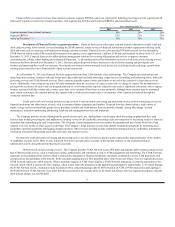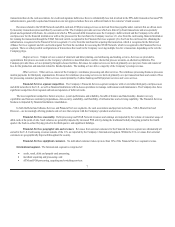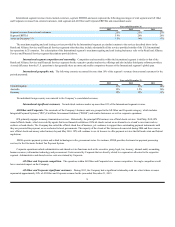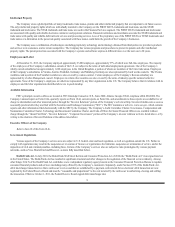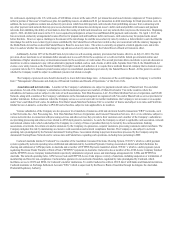First Data 2013 Annual Report Download - page 17
Download and view the complete annual report
Please find page 17 of the 2013 First Data annual report below. You can navigate through the pages in the report by either clicking on the pages listed below, or by using the keyword search tool below to find specific information within the annual report.
The Company may experience breakdowns in its processing systems that could damage customer relations and expose it to liability.
The Company depends heavily on the reliability of its processing systems in the Company’s core businesses. A system outage or data loss could have a
material adverse effect on the Company’s business, financial condition and results of operations. Not only would the Company suffer damage to its reputation
in the event of a system outage or data loss, but the Company may also be liable to third parties. Many of the Company’s contractual agreements with
financial institutions require the payment of penalties if the Company’s systems do not meet certain operating standards. To successfully operate the
Company’s business, the Company must be able to protect its processing and other systems from interruption, including from events that may be beyond the
Company’s control. Events that could cause system interruptions include, but are not limited to, fire, natural disaster, unauthorized entry, power loss,
telecommunications failure, computer viruses, terrorist acts and war. Although the Company has taken steps to protect against data loss and system failures,
there is still risk that it may lose critical data or experience system failures. The Company performs the vast majority of disaster recovery operations itself,
though it utilizes select third parties for some aspects of recovery, particularly internationally. To the extent the Company outsources its disaster recovery, it is
at risk of the vendor’s unresponsiveness in the event of breakdowns in the Company’s systems. Furthermore, the Company’s property and business
interruption insurance may not be adequate to compensate it for all losses or failures that may occur.
The Company may experience software defects, computer viruses and development delays, which could damage customer relations, decrease the
Company’s potential profitability and expose it to liability.
The Company’s products are based on sophisticated software and computing systems that often encounter development delays, and the underlying
software may contain undetected errors, viruses or defects. Defects in the Company’s software products and errors or delays in the Company’s processing of
electronic transactions could result in:
· additional development costs;
· diversion of technical and other resources from the Company’s other development efforts;
· loss of credibility with current or potential customers;
· harm to the Company’s reputation; or
· exposure to liability claims.
In addition, the Company relies on technologies supplied to it by third parties that may also contain undetected errors, viruses or defects that could have
a material adverse effect on the Company’s business, financial condition and results of operations. Although the Company attempts to limit its potential
liability for warranty claims through disclaimers in the Company’s software documentation and limitation-of-liability provisions in the Company’s license
and customer agreements, the Company cannot assure that these measures will be successful in limiting the Company’s liability.
Global economics, political and other conditions may adversely affect trends in consumer spending, which may adversely impact the Company’s
revenue and profitability.
The global electronic payments industry depends heavily upon the overall level of consumer, business and government spending. A sustained
deterioration in the general economic conditions, particularly in the United States or Europe, or increases in interest rates in key countries in which the
Company operates may adversely affect the Company’s financial performance by reducing the number or average purchase amount of transactions involving
payment cards. A reduction in the amount of consumer spending could result in a decrease of the Company’s revenue and profits.
A weakening in the economy could also force some retailers to close resulting in exposure to potential credit losses and transaction declines and the Company
earning less on transactions due also to a potential shift to large discount merchants. Additionally, credit card issuers may reduce credit limits and be more
selective with regard to whom they issue credit cards. Changes in economic conditions could adversely impact future revenues and profits of the Company
and result in a downgrade of its debt ratings which may lead to termination or modification of certain contracts and make it more difficult for the Company to
obtain new business.
The market for the Company’s electronic commerce services is evolving and may not continue to develop or grow rapidly enough for the Company
to maintain and increase its profitability.
If the number of electronic commerce transactions does not continue to grow or if consumers or businesses do not continue to adopt the Company’s
services, it could have a material adverse effect on the profitability of the Company’s business, financial condition and results of operations. The Company
believes future growth in the electronic commerce market will be driven by the cost, ease-of-use, and quality of products and services offered to consumers and
businesses. In order to consistently increase and maintain the Company’s profitability, consumers and businesses must continue to adopt the Company’s
services.
16


